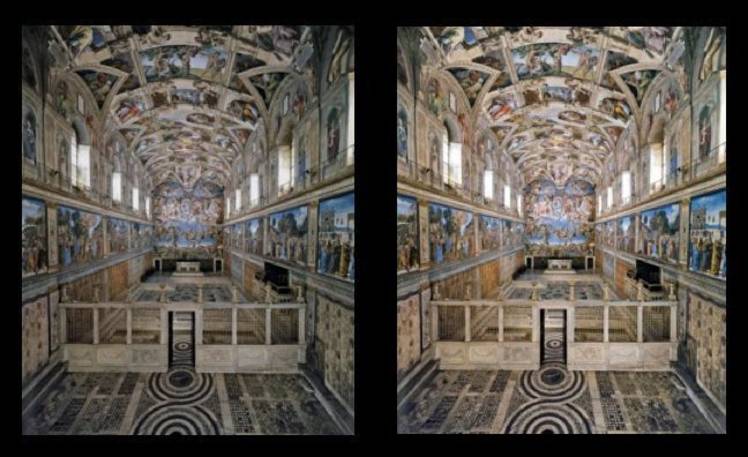


ROME – This week the curtain was raised on a drastically improved Sistine Chapel. Never, ever have its 2,730 square yards of precious wall and ceiling frescoes by Michelangelo, Pinturicchio, Botticelli, Ghirlandaio and other great artists been seen in all their stunning glory as can today’s visitors and, one hopes, visitors in the decades to come. In the words of Italian art critic Helga Marsala, “It’s like a mantle of stars embracing the Chapel.”
It is certainly a literally brilliant display of scientific ingenuity and good taste. Working together for the past three years with top experts from all over Europe, the Vatican laboratories have created an innovative new lighting system that reveals details and subtleties that only Michelangelo himself could have seen.
At the same time the outdated and overwhelmed air conditioning and air exchange system installed twenty years ago has been radically upgraded in order to preserve the Sistine Chapel frescos from the pollution consequent to overcrowding.
That the precious frescoes, now five centuries old, have been at risk is no secret: from the under three million visitors of 20 years ago there are now over six million a year. The Sistine Chapel is an entirely enclosed space, with not a single external door and its dozen windows firmly sealed to avoid outside air pollution. The question has long been how to avoid air pollution from inside – that is, from people’s breath, dust from their clothing, and sweat, especially when Rome’s hottest months coincide with its greatest number of tourists; in high season the Sistine Chapel attracts up to 2,000 visitors an hour. The air conditioning installed in 1994 was not up to the task, and the old-fashioned spotlights added more heat.
.
The new lighting system is the most visible novelty because it permits a clearer view than ever in the past of the frescoes; the lower paintings had never illuminated at all.
First the laboratories of the Vatican and of Pannonia University in Hungary, the Catalonian Energy Research Institute in Spain and Fabertechnica Studio of Lighting Design in Italy studied the effects of Light Emitting Diodes (LED) upon some 260 Sistine Chapel pigment samples. When these studies were complete, the century-old German manufacturer OSRAM installed some 7,000 LED lights, secreted in invisible clusters. OSRAM explains that the benefits are reduction of energy consumption by up to 60% plus elimination of heat emissions and of both ultraviolet and infrared rays. “This new system takes the stress off the paintings,”| OSRAM engineer Roberto Barbieri told the press at the formal presentation Oct. 29 inside the Sistine Chapel. If the new lighting is the immediate showpiece, the air conditioning system is even more important and was designed by Carrier, which had installed the Sistine Chapel’s first air conditioning system aimed to accommodate no more than 700 visitors at a time. Like the LED lights, this system is invisible, installed upon the roof and in hidden spaces beneath the chapel windows. It maintains a temperature of between 20 and 25 degrees C. Telecameras count the number of visitors and adjust the air conditioning units (and hence the humidity) accordingly. In addition, “We had to eliminate dust while at the same time not blowing air onto the frescoes,” a Carrier engineer told me. “This required application of fluid dynamics.” The new system “strategically allows for future updates to help meet the evolving needs of the Vatican,” says Carrier president and CEO Geraud Darnis.
Although an Italian daily announced that limitations upon the number of visitors would be imposed, this is incorrect. Vatican Museums director Antonio Paolucci holds that the Sistine Chapel can contain no more than 2,000 visitors an hour, entering an 20-minute intervals, and that this number will automatically remain stable. “The challenge has been to calculate an air conditioning system that cleans the air of dust but does not blow directly upon the painted surfaces,” a Carrier engineer told me. “To achieve this we had to work with the fluid dynamics of air.”
For Professor Paolucci, access to the Chapel is a question of faith. “The Sistine Chapel is sacred to Catholics all over the world,” he has said repeatedly. “They cannot be excluded when they come to Rome.” Yesterday’s visitors, for example, included a family of twelve Catholics from three generations who made their visit to the Sistine Chapel the high point of a family reunion in Rome, where they had convened from their native Sri Lanka, London and Zurich.
It is implicit that nor can the income be excluded from the ticket sales to tourists like these and for special evening visits organized for small groups through travel agencies or like the private soiree organized by car manufacturer Porsche for its employees and their families.
Source URL: http://iitaly.org/magazine/article/new-light-and-life-sistine-chapel
Links
[1] http://iitaly.org/files/3882038819cappellasistinanuova1414689524jpg